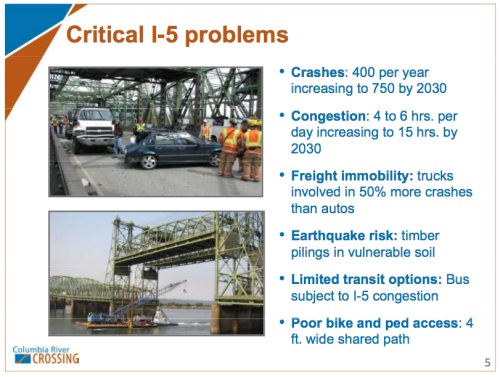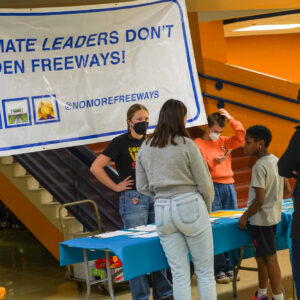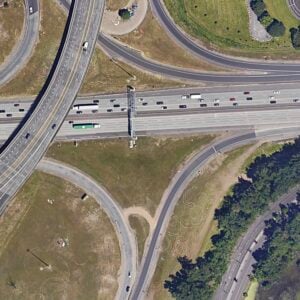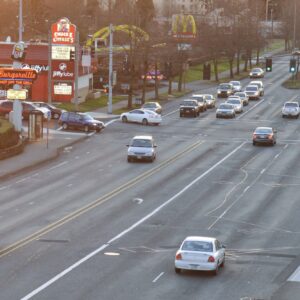HB 2800, a bill that would declare it’s in the state’s interest to “undertake” the Columbia River Crossing project (now referred to as “the I-5 bridge replacement project”) got a public hearing in Salem yesterday. We also heard about a new “bipartisan coalition” that has been formed in opposition to the project.
The hearing yesterday lasted well over four hours and took place in front of a 16-member Joint Committee made up of state legislators. The legislators heard testimony in support of the project from Governor Kitzhaber and heard from dozens of citizens who showed up at the Capitol to share their opinions. From reports we monitored, the crowd was very large, spilling over into two additional rooms in addition to the main hearing room.
According to people that made the trip to Salem, the vast majority of those who testified were opposed to the project (one source said it was 90% in opposition). But the project had a huge boost at the start of the hearing with Governor Kitzhaber, both Co-Chairs of the committee, the Chair of the Oregon Transportation Commisssion, and the ODOT project manager all setting the tone early on. The first two citizen speakers from Hayden Island also gave strong support for moving forward.
The main themes from these boosters of the project were timing (both for funding and to save the bridge from falling down in an earthquake) and safety. One of the committee Co-Chairs (I didn’t get the name) said after a recent meeting with federal representatives he, “Came away convinced that the money is there if we move forward quickly.” Co-Chair Cliff Bentz (R-Ontario) cited the “400 accidents per year” on the bridge and said freight movement is a key concern for his district (which is 375 miles away from the project).
Then, in a strange move that seems to underscore the outdated principles this entire project is based on, ODOT showed a 2002 video explaining the need for highway expansions and a new bridge on I-5 between Oregon and Washington.
Here are a few images from a slide presentation given by ODOT to make the case for project:


Seated in front of the committee, Governor Kitzhaber also struck a sense of urgency. He said, “It is time to build a bridge” and added that the project has been “analyzed, criticized, downsized and looked at at every possible angle (critics refute that claim).” Kitzhaber told legislators that the CRC is a “construction ready project” that it’s needed to alleviate “concerns about congestion from business and community leaders” and that it will “increase mobility and the transportation of goods throughout Oregon.”
On the timing aspect, Kitzhaber made it seem like the project enjoys broad support and that all that’s missing is a funding commitment from Oregon. “We have reached a point of opportunity and some significant urgency,” he said, “We have support of everyone… If we are able to move forward by making a commitment in resources.”
“If we have as much misfortune in building this project as we have had in planning it, or if the other funding sources fall through, and the cost skyrockets, what then? What transportation projects in your districts will you be willing to cut? What programs will you be willing to cut?”
— Testimony from Peter Welte
If Oregon doesn’t move fast, Kitzhaber and others said, the feds will never fund the project. It’s now or never (which is the same thing they’ve been saying for over five years). “If we fail to act, other projects will move up in the queue.”
In his opening remarks, Oregon Transportation Commissioner Chair Pat Egan acknowledged that funding the CRC will impact other state transportation projects. “So we’re keen on finding new revenue.” He estimated the debt service would total $27 million per year on a 30-year time horizon. He said that money could be raised with a one-cent per gallon increase to the gas tax or a $5 per vehicle in registration fees.
[Lack of money to pay for Oregon’s share of the project is likely to emerge as a major sticking point. Biking and walking advocates are especially concerned because debt payments will be pulled directly from a funding source that usually goes to active transportation projects. Sources close to ODOT and PBOT say they’re worried that HB 2800 mandates that bond repayments come from state transportation funds — not the state’s general fund like a previous CRC bill called for. This means ODOT will pull from their “flexible” funds that have historically paid for biking and walking projects throughout the state (stay tuned for more on this).]
Almost immediately after opening statements, the committee began asking tough questions.
Sen. Fred Girod (R-Stayton) seemed annoyed that ODOT Director Matt Garrett wasn’t present to answer questions. He wondered, “Are we robbing Peter to pay Paul? $450 million [Oregon’s share of the project] isn’t a small amount of money.”
Rep. John Davis (R-Wilsonville) asked “Why this bridge? Why now? We have alternatives… What would happen if we just scrap this?” According to one source, that comment led to cheers in the meeting room.
Rep. Julie Parrish (R-West Linn/Tualatin) asked about cost overruns. “What if there is a cost overrun?” she wondered, “I don’t have confidence in the state… I have yet to see big projects that we get accomplished that don’t have overruns.”
The ODOT project manager had responses to these questions — repeating that they hope to find a new revenue stream in the coming years, that they vetted all the design options, and that they are confident in their cost estimates (ODOT’s Kris Strickler said they think they’ll complete it under the estimated cost).
The question is, will committee members and other legislators who will ultimately decide HB 2800’s fate like those answers enough to vote for the bill? Or will legislators take time to understand the grave concerns with this project being aired by a growing number of their constituents?
Washington County resident and board member of Bike Walk Vote Peter Welte was one of those who testified in opposition. He voiced concerns that this project would put funding for other projects at risk. He also pushed back on three common arguments for the project: saying the bridges aren’t in as bad of shape as ODOT says; that ODOT can’t pay for it; and that it won’t “fix congestion.”
Below is a particularly effective passage from Welte’s remarks:
“If we have as much misfortune in building this project — the DOTs have spent over $160 million on a jobs program for highly paid consultants, without laying a brick — as we have had in planning it, or if the other funding sources fall through, and the cost skyrockets, what then? What transportation projects in your districts will you be willing to cut? What programs will you be willing to cut?”
One issue I see emerging is that electeds feel opposition exists only on the extremes. Rep. Parrish tweeted to us that the opposition to the CRC is “fascinating” and that “folks on the far left and the far right are united.” Politically, that’s a dangerous place for the opposition to occupy.
Feeding that narrative is a new coalition in opposition to the project that was announced yesterday. This coalition of very strange bedfellows includes: John Charles of the Cascade Policy Institute; Steve Cole with the Northeast Coalition of Neighborhoods; Karla Kay Edwards with Americans for Prosperity-Oregon; Mara Gross of the Coalition for A Livable Future, and Jason Williams with the Oregon Taxpayer Association. The new group’s number-cruncher is none other than Joe Cortright, President and Chief Economist at Impresa Consulting.
Despite reasonable concerns and seemingly obvious problems with this project, conventional wisdom seems to be that HB 2800 is headed for passage. The political power behind it is daunting (“It has been greased,” said anti-CRC activist Ron Buel during his scathing testimony that called out many of the project’s lobbyists and campaign funding ties); but popular activism against it is gaining steam. If those who oppose this project hope to have a fighting chance to stop, they need a high-profile, moderate and respected voice to emerge. Would even that be enough to stop this steamroller? Stay tuned.
This bill will get another public hearing on Monday (2/18). There’s a citizen’s group already organizing carpools if you’d like to attend.
More coverage of yesterday’s hearing via The Oregonian. You can also read a live-blog from Mismanaging Perception.







Thanks for reading.
BikePortland has served this community with independent community journalism since 2005. We rely on subscriptions from readers like you to survive. Your financial support is vital in keeping this valuable resource alive and well.
Please subscribe today to strengthen and expand our work.
Imagine if Portland Public Schools decided that they would simply sell bonds for rebuilding schools, with no new taxes to pay them back. Citizens and newspaper editors would be outraged. HB 2800 authorizes ODOT to do just that, to the tune of $450 million.
I heard Gov. Kitzhaber express regret that no taxes would be levied to pay back these bonds, but not any reservations about plunging ahead anyway.
Phyrric strategy:
Find the bond rating authority and see what this would do to Oregon’s bond rating if we do go through with it.
They might want to de-rate us preemptively to discourage such a large debt; it is reasonable to predict that without a plan to repay CRC bonds they will after we commit.
Such a bond de-rating could make future state borrowing very painful.
Were any state reps from Portland (where this may actually be built) present and/or vocal? I’m sorry, but I don’t have a lot of faith is reps. and committee members who live 375 miles away.
Those ODOT pics are BS.
“Bus subject to congestion” – Make a 24 hour HOV lane immediately and allow Busses in it! And if ODOT is so worried about freight, allow them in it as well.
“400 crashes a year” and “Congestion” – If we increase # of lanes, we increase # of cars, and we increase crashes, and we increase congestion (Downstream in Portland)
“…”It has been greased,” said anti-CRC activist…”
This damning accusation of graft and corruption should be supported by evidence. Without evidence it is just a baseless rant from the “far left” Unless you want to be dismissed as the new Tre Arrow stick to verifiable facts.
Face it, folks: we’re doomed. We’re going to have a California style ten-lane freeway right through the center of Portland, no matter what anyone says to the contrary. Vested interests get their way, funding or no funding, and ordinary citizens who are interested in having a place to live that’s on a human scale don’t matter.
This bridge is a major component of the I5 corridor uniting N and S, whatever is decided, we need to keep in mind the impacts of moving freight and people. (feel free to insert comments about NAFTA, car congestion/pollution, not enough bike/ped. infrastructure, rail development and so on…)
Oregon has a vibrant export economy, we don’t want to impede on this. We also have a marvelous sustainability culture, we don’t want to ruin this either.
If freight movement and sustainability are important issues for you, then the solution is obvious: congestion pricing. The biggest impediment to freight movement are SOVs on the bridge during commuting hours. Congestion pricing and mass transit are the only want to fix this problem. Adding lanes will just add more cars.
http://en.wikipedia.org/wiki/Induced_demand
I don’t think that anyone is denying the importance of this bridge, (and I do not think we condemned to the CRC yet, either!) I think Matthew accurately sums things up: Oregon has long history of smart, practical planning that creates maximum liveability through creating jobs, walk and bike-able communities, and protecting environments. This bridge flies in the face of the all of the great things about Oregon. There are ways to support the movement of freight and
buses, and making sure or bridge can withstand an earthquake without sacrificing environmental, community, personal and fiscal health.
So you want the interstate freight shipping corridor to remain unencumbered? Take i-205 – that’s what it was built for, an urban bypass for Portland. Guess what happened? Suburbs sprang up around it. Still, i-205 was meant to be that bottleneck solution.
Exactly John, I was going to say the same thing!
I-205 helps freight traffic passing through between Salmon Creek and Sherwood. A big chunk (I don’t know what fraction) of what the CRC propaganda refers to as “Freight Immobility” on the I-5 bridge is more local, going to or from Portland and Vancouver ports and industrial areas, and I-205 doesn’t help that. I don’t think that sweeping that issue under the rug helps stop the CRC, but well-grounded facts about that freight traffic might, and CSA offers another (better!) solution to it.
“Oregon has a vibrant export economy, we don’t want to impede on this. We also have a marvelous sustainability culture, we don’t want to ruin this either.”
The problem is the CRC is the opposite of vibrant or sustainable. It would be a stranded asset. http://www.carbontracker.org/unburnable-carbon/stranded-assets Something we come to regret having built and don’t know what to do with because the conditions/logic which was used to justify and build it changed and now no one wants or needs it (never mind not wanting to pay down the debt… for thirty years! Any infrastructure that is based on the assumption that car ownership and use will continue into the future or even grow is insane and wishfully ignores the writing on the wall. I’m sure it is tiresome to hear me say this as much as I do, but much smarter people than I are convinced it is already too late to do much about the effects of climate change underway. Expanding freeways in 2013 is so misguided and obsolete it is hard to know where to begin.
Smart people who are following this closely are telling us this is not just a bridge retrofit but a massive expansion of auto-only infrastructure to supposedly deal with problems, that simple, cheap, quick fixes like tolls, HOV lanes, or doing nothing and letting the decline in VMT continue and accelerate on its own could solve quicker than building this thing. If we do go ahead with this I will bet money that before it’s done VMT will have continued to decline, gas will be more expensive, car ownership will have lost its social value or status, and we’ll look back on this project as the biggest folly this state ever undertook. Talk about timing. Ha. The time is right for weaning ourselves from dependence on the automobile, not building concrete monuments to its indefinite future.
Even if people drove half as much as now, in 40 years there will be twice as many people living in the area. The present bridge has been horrible as far back as I can remember. We need the bridge now. If it turns out that some biking and public transportation utopia occurs 50 years from now, it can be torn down. I doubt that will happen.
“If it turns out that some biking and public transportation utopia occurs 50 years from now, it can be torn down.”
I am not talking about a utopia but constraints that I’d venture will manifest themselves in <5 years not 50.
If this is the same Matthew I think it is, this might be the politest comment in favor of the CRC boondoggle I’ve seen you post online.
nope wasn’t me, i own my comments by using my full name. when i state my opinion on the crc many portland folks (friends included) would want to break out the pitchforks & torches.
30 seconds. That is how much this expansion will decrease transit time according to the estimates. Total cost for this bridge is how much per second saved?
The CLF and a coalition of neighborhoods are “the far left”‘?
I always thought that Occupy and The Portland Radicle were far left, but apparently I’ve been misinformed.
Thanks for the comprehensive coverage, Jonathan. It’d be great to have you down in Salem next week!
I still hear “People’s Republic of Portland” and references to our “fascist/communist Portland metro area” from out of to owners and outer Clackastanians.
<sarcasm >
New York city and California get a pass on this apparently because we are the root of all evil. </sarcasm >
Sharing logical talking points between the right and the left puts us in the common sense middle. Clean air and transportation funding fairness aren’t extreme ideas at all.
I suggest bringing pictures of Beijing’s recent air pollution and asking:
“Is becoming a major freight and industrial hub worth this?!?”
Point to slides of impenetrable smog, all citizens wearing face masks and over crowded hospitals due to China’s single minded focus on commerce and ask again:
“Is it worth it?”
Funny how Kitzhaber never voiced his support of the bridge during the election? If he had I wouldn’t have voted for him (or the other guy).
Speaker of the House, Tina Kotek, generally a reasonable sort .. her district is North Portland, including Kenton and Hayden Island. Her advocacy has included kids and health issues. A few thousand emails, phone calls and letters reminding her of the negative impacts to her district seem in order.
Where the leadership goes, the troops follow. Best make sure she is on the right course. Previous conversations with her have been rather non-committal.
Too late. She has sold out. I recently asked her what she is doing to help protect her constituants from the destruction of this proposed highway expansion project. All I got was lies. She sounded like a CRC commercial using the exact same phrases as the representatives from CRC booths.
What effect will sequester have on this project? Hopefully America’s dysfunctional Congress will lay it to rest as of March 2.
That is probably our best hope at this point. I honestly hope that the federal infrastructure spending gets cut to the bone, along with a lot of other programs. The vast majority of infrastructure spending in the U.S. is going to the wrong things. Our only chance is to control taxing and spending at the local level.
Listen to you people “Phyrric strategy”, “We’re Doomed”, “Beijing’s recent air pollution” and now hoping for the sequester which would likely drop us back into recession.
Overblown hyperbole and destructive nihilism is no way to make friends or influence people.
Decreased transit time- 30 seconds
Dangerous bridge- not even in the top ten
Funding source/Tolling- Numbers on the bridge have decreased for a number of years.
Height- not high enough for the current local businesses, let alone the future.
Jobs- Temporary road jobs vs manufacturing jobs lost due to low bridge
America is going to continue to decline economically. Read the writing on the wall. The sooner you start planning for a less prosperous future, the better. In 10 years we are going to kick ourselves for moving forward with this project.
Chris it is one thing to prepare for a less prosperous future and another thing entirely to root for it and work toward that end.
“Chris it is one thing to prepare for a less prosperous future and another thing entirely to root for it and work toward that end.”
Granpa,
do you really believe this is up to us? That we get to decide? We decided thirty years ago to keep on truckin, keep burning the fossil fuel candle at both ends. Now it may be too late to avert disaster. What I suspect Chris is saying is not that this is the best thing that could happen but that preparing for it is wise. I couldn’t agree more. See USers have gotten used to calling the shots, getting everyone else to do our bidding, including the planet. All that is probably coming to an end–soon–and pretending this all doesn’t concern us isn’t going to be very prudent.
But I’m glad you’re into preparing for a different future. We agree!
You are obviously missing our main assertion about this CRC project.
We contend that building it not only will not make our future more prosperous but that the build out of the entire project will REDUCE prosperity, incur a crippling debt that the state can ill afford and set the groundwork for another “mandatory, absolutely MUST HAVE!!!” project widening I-5 from the CRC through at least downtown.
We could ask that you read authoritative analyses of the misdirection and lies used to justify the CRC project. Websites like SmarterBridge.org show and like to the CRC’s own Seismic Panel Executive Summary where they admit that the bridge can be made perfectly safe with from $190 million to $265 million in repairs.
Or perhaps that the continual predictions of every increasing traffic demand are based on out of date data, analysis methods and fail to take into account recent declines in private automobile use that are not explained by economic contraction but are widely shown to be generational and societal in nature. Let’s be blunt: even at my age of 37 I can concede of a time when a car was absolutely necessary to survive; this is no longer the case in urban and suburban areas. What’s worse is that automobile prices have far outstripped median income growth amongst the current and upcoming generation. Simply put the automobile is pricing itself out of existence. Ignoring public transportation, the internet is making carpooling, ride sharing, car sharing and telecommuting increasingly easy and more the norm. In this light the insistence by a DOT that traffic demand will continue to grow a 1950’s levels is laughable at best, fraudulent at worst.
The times they are a changing.
We have neither the means nor the need of this bridge and highway project.
Unbridled urban sprawl and overdevelopment is a path that will lead Oregon directly to ruin.
Marid wrote:
“Even if people drove half as much as now, in 40 years there will be twice as many people living in the area.”
You seem to ‘know’ something very specific about demographic trends, but when someone suggests the future of the automobile will not be a continuation of the past you can’t hear that, reject it out of hand. We obviously get our news from different sources, but have you noticed that the number of folks jumping on the climate change is advancing more rapidly, is probably already too far advanced to do most of the things about it we wished we had bandwagon is rapidly increasing? Every day brings new converts.